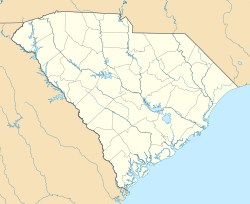Bloody Point Range Lights facts for kids
|
|
|
| Coordinates | 32°05′49.7″N 80°52′23.5″W / 32.097139°N 80.873194°W |
|---|---|
| Year first constructed | 1883 |
| Year first lit | 1883 |
| Deactivated | 1922 |
| Construction | Wood |
| Tower shape | Dormer window on roof of house |
| Height | 27 feet (8.2 m) (Original Front) 91 feet (28 m) (Original Rear) |
| Focal height | 81 feet (25 m) (Original Rear) |
| Original lens | Red steamer lens (Front and Rear) |
| Current lens | Decorative |
The Bloody Point Range Lights, also known as the Bloody Point Lighthouse, were special lights on the southern tip of Daufuskie Island in Beaufort County, South Carolina. These lights were built in 1883. They helped ships find their way safely.
Over time, the land around the lights started to wear away due to erosion. Because of this, the front light had to be moved. It was placed where the back light used to be and became the new back light. These lights worked as official guides for ships until 1922. Today, the original Front Range Light building is a private home.
Bloody Point is the name of the southern part of Daufuskie Island. It got this name because of a historical event. During the Yamasee War in 1715, there was a lot of fighting in this area.
Contents
Building the Original Range Lights
In 1871, the U.S. Congress decided to build two sets of range lights on Daufuskie Island. The other set of lights was called the Haig Point Range Lights, located on the northern side of the island. In 1882, the government bought about 6.72 acres of land for the Bloody Point lights.
The Front Range Light
The Front Range Light was a red, kerosene lamp. It was placed in a special window on the roof of the lightkeeper's house. This house was built by James C. LaCoste. It stood near the beach on about 1.72 acres of land. The light itself was about 27 feet (8.2 m) high.
The Rear Range Light
The Rear Light was a tall, triangular tower made of iron. It was about 91 feet (28 m) tall. Cooper Manufacturing in Mount Vernon, Ohio built this tower. John Michael Doyle, who worked for the company, helped set up the tower. It was built on a concrete base on a 5-acre plot of land. This spot was about 4,350 feet (1,330 m) away from the front light, further inland.
Doyle became the first person to look after the lights, called the light keeper. A small brick building, sometimes called a wick house, was built at the bottom of the tower. This building stored the lamp during the day. At night, a red steamer lamp with a special reflector was lifted up on rails. It reached a height of 81 feet (25 m). The Bloody Point Range Lights officially started working in 1883. A brick oil house was also built nearby to store kerosene.
Changes Over Time
Because of the land wearing away (erosion), the front light had to be moved in 1899. It was placed closer to where the rear light had been, which was taken down. In its new spot, the old front light became the new rear light.
A new front light was built. It was a 45 feet (14 m) tall wooden house on metal legs. This new light was placed on land that was rented near the shore. The metal legs rested on metal disks. These disks allowed the light to be moved across the beach as the water channel changed. This light was moved several times over the next twenty years. The range lights were stopped from working in 1922.
New Uses for the Buildings
In 1925, the lightkeeper's house was sold. The original front range light had already been lost to erosion. The house was sold at an auction. Then, it was sold again to its last light keeper, Gus Ohman. In 1926, he sold it to a former assistant light keeper, Arthur A. "Papy" Burn, Jr. Papy Burn lived there for about 40 years.
In 1953, Papy Burn started making wine. He used fruits like blackberries, elderberries, and scuppernongs. He made the wine in the old lamp house or the oil house. Even though it was a small operation, he called the building the Silver Dew Winery. The writer Pat Conroy described these two small brick buildings with the Silver Dew Winery sign in his book The Water is Wide.
In 1981, the house was fixed up and became a private home. Later, the property was taken by the government because of unpaid taxes and sold. It was bought at an auction in the Beaufort County Courthouse in 1983. After being used for a short time as a shop for a golf course, it is now a private home again.
The old Front Range House is considered a special historical building. It is part of the Daufuskie Island Historic District, which is listed on the National Register of Historic Places. You can find more information and pictures from the South Carolina Department of Archives and History.


